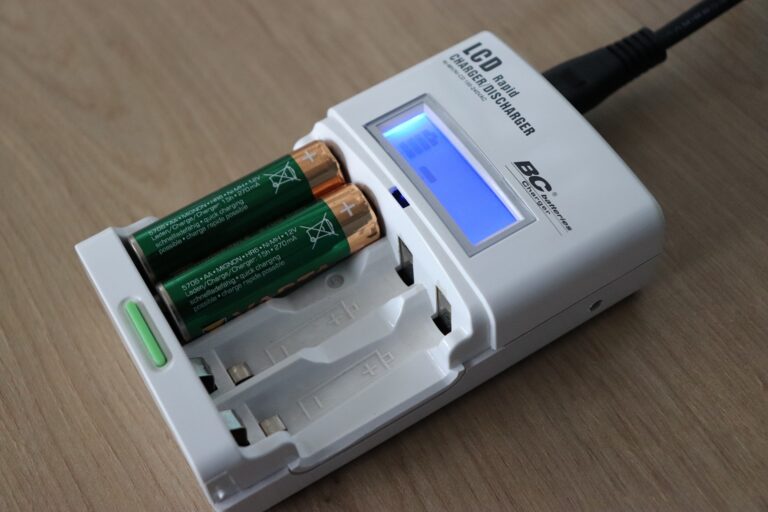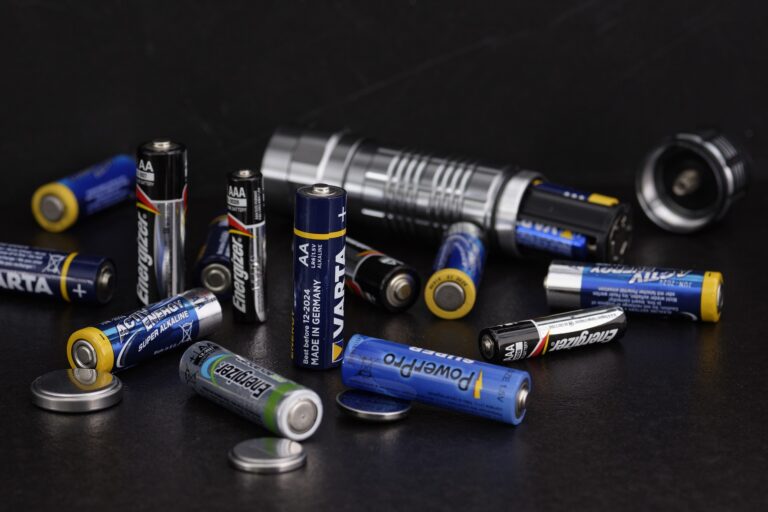Batteries are an essential part of our daily lives, powering everything from small household devices to large industrial machines. Whether you’re using a remote control, a medical device, or a car, batteries are indispensable. As we become more reliant on portable electronics and renewable energy storage, learning the basics about batteries is vital to making informed decisions for both personal and business applications.
Batteries and Their Various Uses
Batteries are used in a vast array of applications, from tiny hearing aids to massive grid-scale energy storage systems. Here are some common uses:
- Portable Electronics: Smartphones, laptops, tablets, and cameras all rely on rechargeable batteries, typically lithium-ion.
- Household Devices: AAA batteries, AA batteries, C batteries, and D batteries power a wide range of household items like remote controls, toys, and flashlights.
- Automotive: Lead-acid batteries start most vehicles, while electric vehicles use large lithium-ion battery packs.
- Medical Devices: Specialised batteries are often used for medical devices such as pacemakers, hearing aids, defibrillators, and other portable equipment.
- Emergency and Safety Equipment: Smoke detectors, emergency lighting, and backup power systems rely on different types of batteries.
- Industrial Applications: Forklifts, uninterruptible power supplies, and remote sensing equipment often use heavy-duty batteries.
- Renewable Energy Storage: Large-scale battery systems are increasingly used to store energy from solar and wind power for use when these sources aren’t producing.
- Space Exploration: Specially designed batteries power many spacecrafts and rovers exploring our solar system.
- Ocean Exploration: Batteries power autonomous underwater vehicles that explore the deepest parts of our oceans.
Batteries come in a wide variety of shapes, sizes, and chemistries, each designed for specific applications. The two main types are primary or single-use and secondary or rechargeable batteries.
Primary Batteries
Primary batteries are designed for single use and are discarded after they’re depleted. They’re commonly used in devices with low power requirements or infrequent use.
- Alkaline Batteries: Alkaline batteries are the most common type of primary battery. They’re available in various sizes, including AAA batteries, AA batteries, C batteries, and D batteries. Alkaline batteries have a long shelf life and are relatively inexpensive, making them popular for household devices like remote controls, flashlights, and wall clocks.
- Lithium Batteries: Lithium batteries offer higher energy density and longer shelf life compared to alkaline batteries. They’re often used in devices that require high performance or have a long service life, such as smoke detectors, medical devices, and some cameras.
- Silver Oxide Batteries: These small, button-shaped batteries are commonly used in watches, calculators, and hearing aids. They provide a stable voltage and have a long shelf life.
- Zinc-Air Batteries: Primarily used in hearing aids, these batteries are activated when exposed to air. They have a high energy density, but a limited operational life once activated.
Secondary (Rechargeable) Batteries
Secondary batteries can be recharged and used multiple times, making them more cost-effective and environmentally friendly for high-drain devices or frequent use applications.
- Lithium-Ion (Li-ion) Batteries: Li-ion batteries are the most common rechargeable batteries in portable electronics like smartphones, laptops, and tablets. They offer high energy density, low self-discharge, and no memory effect. However, they require careful management to prevent overheating and potential safety issues.
- Nickel-Metal Hydride (NiMH) Batteries: NiMH batteries are often used as rechargeable alternatives to AA batteries, C batteries, and D batteries. They offer higher capacity than older nickel-cadmium batteries and are more environmentally friendly. NiMH batteries are commonly used in digital cameras, remote-controlled toys, and other high-drain devices.
- Lead-Acid Batteries: These are the oldest type of rechargeable battery and are still widely used in automotive applications, uninterruptible power supplies (UPS), and large-scale energy storage. While they’re heavy and have low energy density, they’re reliable and can deliver high currents when needed.
- Nickel-Cadmium (NiCd) Batteries: Once popular in portable electronics, NiCd batteries have largely been replaced by NiMH and Li-ion batteries due to environmental concerns about cadmium. However, they’re still used in some power tools and emergency lighting due to their ability to withstand harsh conditions.

Battery Sizes
With so many different uses for batteries, it only makes sense to have different sizes. Here are the most common battery sizes available in the market.
- AA Batteries: AA batteries are among the most widely used battery sizes globally. They are typically used in household devices such as remotes, clocks, and toys. AA batteries can be either disposable (alkaline) or rechargeable (nickel-metal hydride or lithium-ion). The voltage for AA batteries is usually 1.5V for single-use and 1.2V for rechargeable ones.
- C Batteries: C batteries are larger than AA and are often used in devices that require higher power levels over a longer period, such as flashlights, radios, and some toys. They are also available in both alkaline and rechargeable varieties, with similar voltage characteristics to AA batteries. Their size allows them to store more energy, making them ideal for devices with moderate power consumption.
- D Batteries: D batteries are the largest among standard cylindrical batteries. Their larger size means more stored energy, making them perfect for prolonged usage in devices requiring significant power. D batteries are used in devices like large flashlights, boomboxes, and radio transmitters. They are primarily available in alkaline and rechargeable forms.
- Button Cell Batteries: Button cells, also known as coin batteries, are small, flat batteries used in compact devices such as watches, hearing aids, and some medical instruments. Their compact design allows them to fit into tiny spaces, but they also have lower power output compared to larger batteries like AA and C batteries.
Other battery sizes include AAA, 3V, and 9V batteries.
Different Parts of a Battery
While the specific components can vary depending on the battery type, most batteries share some common elements:
- Anode (Negative Electrode): This is the negative terminal of the battery and the source of electrons.
- Cathode (Positive Electrode): This is the positive terminal of the battery and accepts electrons from the external circuit.
- Electrolyte: This is a substance that allows ions to move between the anode and cathode. It can be liquid, gel, or solid.
- Separator: This is a physical barrier between the anode and cathode that prevents short circuits while allowing ions to pass through.
- Current Collectors: These conduct the current from the active materials to the battery terminals.
- Casing: This contains all the components and protects them from the environment.
How a Battery Works
A battery is essentially a device that stores chemical energy and converts it into electrical energy. This process occurs through an electrochemical reaction within the battery’s cells. Here’s a simple breakdown of how a typical battery works:
- Discharge Cycle: When a battery is connected to a device, electrons flow from the anode to the cathode through an external circuit, providing power to the device. Inside the battery, positively charged ions move through the electrolyte from the anode to the cathode, balancing the charge flow.
- Chemical Reaction: The materials in the anode and cathode undergo chemical reactions that release and accept electrons. For instance, in an alkaline battery, zinc at the anode reacts with the electrolyte, releasing electrons, while manganese dioxide at the cathode accepts electrons, completing the circuit.
- Energy Transfer: This flow of electrons through the external circuit is what powers your device. Once the chemical reactions are exhausted, the battery is depleted.
- Rechargeable Batteries: In rechargeable batteries like lithium-ion or nickel-metal hydride, the chemical reactions are reversible. When connected to a power source, the flow of electrons is reversed, restoring the original chemical state of the anode and cathode, allowing the battery to be used multiple times.
Interesting Facts About Batteries
- Ancient Origins: The first known battery, called the Baghdad Battery, dates to around 250 BCE in Mesopotamia.
- Batteries Were Invented in 1800: The first true battery was invented by Italian scientist Alessandro Volta in 1800. His “voltaic pile” was made of alternating layers of zinc and copper, separated by cloth soaked in saltwater.
- International Battery Day: International Battery Day is celebrated on February 18th in the United States, commemorating the birthday of Alessandro Volta, who invented the first electrical battery.
- AA Battery Sales Are Skyrocketing: Despite advancements in rechargeable technologies, AA batteries remain popular. According to industry reports, AA batteries have a global sales revenue of over AUD 10 billion and will continue to grow each year.
- Biodegradable Batteries: Researchers are developing batteries made from organic compounds that can decompose safely in the environment. While these batteries are yet to be commercially available, there are eco-friendly options in the market. Energizer’s Ultimate Lithium range claim to be the world’s longest-lasting batteries, which can help reduce the need to frequently buy single-use products. Meanwhile, Energizer’s Recharge Extreme range is the world’s first battery range that’s made with 22% recycled materials, including 4% recycled battery content.
- Battery Lifespan: The lifespan of a battery varies greatly. Some disposable batteries can last for years on the shelf, while some rechargeable batteries can be charged thousands of times before degrading significantly.
Understanding the different types of batteries, how they work, and how to use them effectively can help us make better choices in our daily lives and contribute to more sustainable energy use. Whether you’re choosing between AA batteries, C batteries, or D batteries for your household devices, or considering the battery technology in your next electric vehicle, this knowledge empowers you to make informed decisions.
As we look to the future, batteries will continue to play a crucial role in our transition to renewable energy and more sustainable technologies. Ongoing research into new battery chemistries, improved recycling methods, and innovative applications promises to keep batteries at the forefront of technological progress for years to come.

